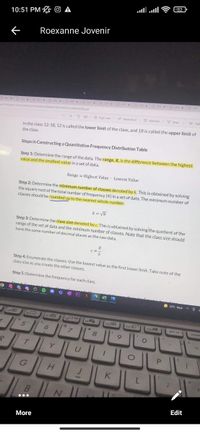
MATLAB: An Introduction with Applications
6th Edition
ISBN: 9781119256830
Author: Amos Gilat
Publisher: John Wiley & Sons Inc
expand_more
expand_more
format_list_bulleted
Question
891, 937, 959, 1017, 1047, 1097, 1169, 1173, 1184, 1235, 1266, 1345, 1353, 1357, 1391, 1414, 1453, 1524, 1557, 1581, 1583, 1590, 1658, 1685, 1690, 1734, 1744, 1765, 1776, 1783, 1783, 1790, 1797, 1849, 1862, 1888, 1894, 1895, 1901, 1906, 1928, 1941, 1949, 1952, 1960, 2022, 2037, 2048, 2052, 2058, 2067, 2103, 2109, 2113, 2163, 2178, 2240, 2245, 2269, 2288, 2452, 2651, 2668, 2886, 2921, 3045, 3276, 3356, 3439, 3749, 4387, 4437, 4578, 4899, 5000, 5290, 5404, 5867, 6128, 6666, 7103, 7757, 7999, 8019, 8773, 9296, 9475, 9595, 9838, 10016
create a table of frequency using this formula. show your solution

Transcribed Image Text:32
10:51 PM O A
Roexanne Jovenir
AD X
F x
ANx UN
Dr xa MC x
X Cax x
UNx
2/SECONDSEMESTER/STATS/OANNOATED pat
O Add text
V Oraw
Y Hig
+ 2 E Page view A Read aloud
In the class 12-18, 12 is called the lower limit of the class, and 18 is called the upper limit of
the class.
Steps in Constructing a Quantitative Frequency Distribution Table
Step 1: Determine the range of the data. The range, R, is the difference between the highest
value and the smallest value in a set of data.
Range = Highest Value - Lowest Value
Step 2: Determine the minimum number of classes denoted by k. This is obtained by solving
the square root of the total number of frequency (N) in a set of data. The minimum number of
classes should be rounded up to the nearest whole number.
k = VN
Step 3: Determine the class size denoted by c. This is obtained by solving the quotient of the
range of the set of data and the minimum number of classes. Note that the class size should
have the same number of decimal places as the raw data.
R
Step 4: Enumerate the classes. Use the lowest value as the first lower limit. Take note of the
class size as you create the other classes.
Step 5: Determine the frequency for each class.
O 33°C Haze A 6
no
F11
F12A
prt sc
Insor
7.
Y
P.
H.
K
...
Edit
More
Expert Solution
This question has been solved!
Explore an expertly crafted, step-by-step solution for a thorough understanding of key concepts.
Step by stepSolved in 2 steps with 1 images

Knowledge Booster
Similar questions
- what is the pattern for 44,22,20,10,8 ___ and what comes nextarrow_forward19 As of 2011, the following are the ages at which a country's presidents were inaugurated. 48,68,44,61,64,67,44,48,47,65,53,69,44,67,58,46,45,52,55,47,56,57,58,47,54,,42,65,69,68,60,66,68,64,54,56,44,48,46,42,49,54,57,69,52 Construct a grouped frequency distribution for the data. Use 41 - 45 for the first class and use the same width for each subsequent class. Type the frequency value for each class. Age Frequency 41-45 ________arrow_forward3 As of 2011 the following are the ages which a country’s president were inaugurated. 60,53,68,46,66,64,67,58,62,68,47,45,55,51,51,69,43,47,63,57,47,68,60,64,67,58,69,56,65,59,46,45,59,53,43,63,54,64,69,55,57,64,67,42 construct a good frequency distribution for the data. Use 41-45 for the first class and use the same width for each subsequent class. type the frequency value for each class.arrow_forward
- Is there more than one number between 8.45 and 8.47? If so, find two such numbers.arrow_forwardCalculate the sum and the average amount of time for 54, 534, 960, 641, 249, 105, 263, 120, 725, 618, 702, 257, 331, 324, 266, 660, 236, 1865, 437, 850.arrow_forwardNote: This is for practice only, this will not affect my grade.arrow_forward
arrow_back_ios
SEE MORE QUESTIONS
arrow_forward_ios
Recommended textbooks for you
 MATLAB: An Introduction with ApplicationsStatisticsISBN:9781119256830Author:Amos GilatPublisher:John Wiley & Sons Inc
MATLAB: An Introduction with ApplicationsStatisticsISBN:9781119256830Author:Amos GilatPublisher:John Wiley & Sons Inc Probability and Statistics for Engineering and th...StatisticsISBN:9781305251809Author:Jay L. DevorePublisher:Cengage Learning
Probability and Statistics for Engineering and th...StatisticsISBN:9781305251809Author:Jay L. DevorePublisher:Cengage Learning Statistics for The Behavioral Sciences (MindTap C...StatisticsISBN:9781305504912Author:Frederick J Gravetter, Larry B. WallnauPublisher:Cengage Learning
Statistics for The Behavioral Sciences (MindTap C...StatisticsISBN:9781305504912Author:Frederick J Gravetter, Larry B. WallnauPublisher:Cengage Learning Elementary Statistics: Picturing the World (7th E...StatisticsISBN:9780134683416Author:Ron Larson, Betsy FarberPublisher:PEARSON
Elementary Statistics: Picturing the World (7th E...StatisticsISBN:9780134683416Author:Ron Larson, Betsy FarberPublisher:PEARSON The Basic Practice of StatisticsStatisticsISBN:9781319042578Author:David S. Moore, William I. Notz, Michael A. FlignerPublisher:W. H. Freeman
The Basic Practice of StatisticsStatisticsISBN:9781319042578Author:David S. Moore, William I. Notz, Michael A. FlignerPublisher:W. H. Freeman Introduction to the Practice of StatisticsStatisticsISBN:9781319013387Author:David S. Moore, George P. McCabe, Bruce A. CraigPublisher:W. H. Freeman
Introduction to the Practice of StatisticsStatisticsISBN:9781319013387Author:David S. Moore, George P. McCabe, Bruce A. CraigPublisher:W. H. Freeman

MATLAB: An Introduction with Applications
Statistics
ISBN:9781119256830
Author:Amos Gilat
Publisher:John Wiley & Sons Inc

Probability and Statistics for Engineering and th...
Statistics
ISBN:9781305251809
Author:Jay L. Devore
Publisher:Cengage Learning

Statistics for The Behavioral Sciences (MindTap C...
Statistics
ISBN:9781305504912
Author:Frederick J Gravetter, Larry B. Wallnau
Publisher:Cengage Learning

Elementary Statistics: Picturing the World (7th E...
Statistics
ISBN:9780134683416
Author:Ron Larson, Betsy Farber
Publisher:PEARSON

The Basic Practice of Statistics
Statistics
ISBN:9781319042578
Author:David S. Moore, William I. Notz, Michael A. Fligner
Publisher:W. H. Freeman

Introduction to the Practice of Statistics
Statistics
ISBN:9781319013387
Author:David S. Moore, George P. McCabe, Bruce A. Craig
Publisher:W. H. Freeman